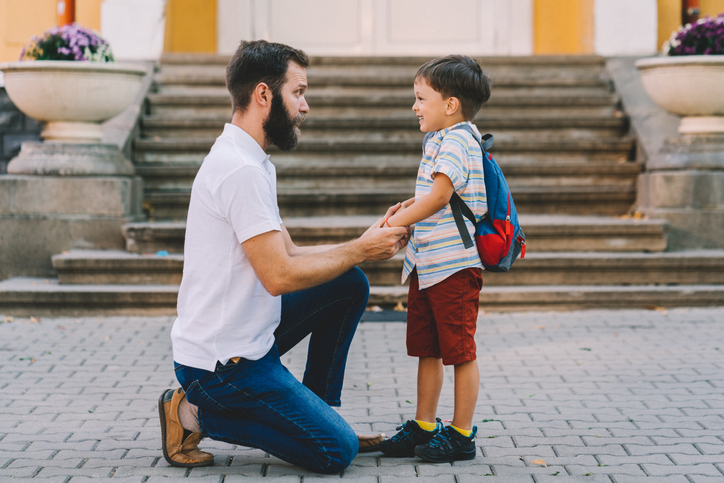9 Tips for Helping Autistic* Children Transition to a New School
Can you imagine starting at a new school in an entirely unfamiliar environment? Coping with a schedule change and new teachers, staff members, and peers is often nerve-racking for many students, but those with autism tend to have an especially hard time making changes and adapting to major life, academic, and social transitions.
Some common difficulties that autistic students may display or encounter during particularly stressful periods of transition include:
- Reduced self-regulation skills
- Limited interactions with instructors and peers
- Difficulty remaining actively engaged in the classroom setting
- Trouble focusing appropriately during school hours
- Heightened anxiety levels and an increased sensitivity to sensory stimuli
- A desire for sameness and familiarity in one’s daily routine
- Difficulty understanding transition cues throughout the school day
- Insistence on predictability in the school, home, and treatment setting
- Challenges pertaining to the transitioning from one class, activity, or task to the next
- Poor social skills compared with typically-developing peers
- Restrictive or repetitive behaviors–like stimming, rocking, or rubbing fingers or feet together
These traits are commonly associated with autism and can cause significant difficulty during transition periods–such as adjusting to a new school environment, academic schedule, or daily routine. Considering this, it is important to develop and implement individualized plans geared toward educational success for each student with learning differences.
9 Tips for Developing a Personalized Plan
It is well-known that difficulty adapting to changes in one’s routine, daily activities, and environment is a hallmark characteristic of many on the autism spectrum. When addressing transitions of any kind, it is essential to, first, evaluate the unique needs of the learner and, then, create a personalized plan to help the adjustment process take place as smoothly as possible.
Although transitioning to a new school can be quite difficult for those with autism, here are some strategies that can make the process easier:
- Help the child know what to expect by creating a detailed transition plan and setting specific learning goals.
- Take a tour of the new school with your child to meet their teachers, staff members, and peers before the first day.
- Create a countdown calendar and implement a visual schedule for each day.
- Use picture cards to cue the transition from one activity to the next.
- Host a back-to-school party to help your child get excited for their first day and meet other children.
- Establish predictability by preparing the student for schedule changes in advance.
- Practice new routines prior to the first day of school.
- Advocate for evidence-based interventions.
- Remember that communication with your child–and their academic team–is key!

1. Help the student know what to expect by creating a detailed transition plan and setting specific learning goals.
A transition plan outlines a student's strengths, weaknesses, and any presenting concerns–like medical or mental health issues. Detailing specific difficulties that may arise when transitioning to a new environment or activity can be included–as well as any social, educational, or behavioral goals for the child.
The plan should also cover notes from the student’s former teachers and treatment providers. It might outline the support your child will need in their new academic environment and provide a summary of personal IEP goals. Learning plans should outline any effective interventions being used with the student and address the child’s reinforcement schedule by including any reinforcers, rewards, or activities the student enjoys.
It is essential to ensure that all school personnel have up-to-date information, medical records, and current diagnostic information for your child. Go over any inconsistencies between academic goals or criteria for reinforcement in the home and school environment, and discuss relevant interventions with the student’s support team.
2. Take a tour of the new school with your child to meet their teachers, staff members, and peers before the first day.
If possible, call the school your child will be attending and set up a time to visit. Ask if your child can meet their new teachers, support team, or classmates in advance. It can also be helpful for your child to get a visual of the school floor plan when visiting.
Sometimes meet-and-greets are held before school starts to allow students to meet their classmates, teachers, and support team. During this time, consider navigating the halls with your child to show them where their classroom will be–as well as the lunchroom, playground, library, and bathrooms.
3. Create a countdown calendar and implement a visual schedule for each day.
Using a visual schedule with task activity cards is a great way to familiarize students with their new daily routine. Request a detailed schedule from your child’s school–including the start time, lunch and snack breaks, recess, and any other pertinent activities–to include in the visual schedule. If possible, aim to implement this routine at home a few days prior to the start of school, as this will help your child adapt to their new routine ahead of time.
Moreover, a countdown calendar can also be created to help your child visualize the number of days remaining until the first day of school. To make this, cut up colored construction paper into strips and staple the strips together into rings that form a chain. The links in the chain represent the number of days left until school begins. Have your child tear off a link in the chain each day and provide reinforcement–such as a special breakfast, small toy, or fun activity–to help your child celebrate their first day!

4. Use picture cards to cue the transition from one activity to the next during adjustment periods.
Activity cards can be implemented as visual reminders to prompt the completion of tasks throughout the school day. For students who benefit from visual images, pictures of the task or activity may be included on the card along with a word spelling of the task, like “Bathroom” or “Lunch.” A math task card, for example, could have a photo of the math classroom’s door on it–along with a mathematical equation or symbol and the word “Math'' to remind the student about their class.
Consider incorporating a “To Do” and “Finished” box for activities that will be completed throughout the day. If this strategy is initially implemented at home, ask your child’s new teacher if they can bring the task cards with them to school to help the transition process take place more smoothly. Mention any prompts that your child requires–including light physical or verbal reminders–to use the task activity cards appropriately. This strategy can also be paired with time management skills to teach students how to effectively manage their time during and after school hours.
5. Host a back-to-school party to help your child get excited for their first day; encourage them to meet new classmates, peers, and friends.
Back-to-school parties can be an engaging way to celebrate the start of a new school year. The party can be simple and short – an hour, with one activity and a fun snack like mini cupcakes. The party should be a time for your child to:
- Get to know new friends
- Learn how to use social skills to interact in social situations
- Have fun and celebrate the upcoming first day of school with new peers
Getting to know classmates in advance can help alleviate anticipatory anxiety for your child leading up to their first day. Never underestimate the power of having a friend to sit next to and talk with!

6. Establish predictability by preparing the student for schedule changes in advance.
Talk through and anticipate any challenges that may arise for your child with autism during their first day of school. Discuss how to seek help in the event of mounting confusion and feelings of being overwhelmed or frustrated. Typically, it is best to speak with your child’s teachers, aides, and support team in advance and plan for any challenges that could arise. Describe social, emotional, and behavioral difficulties that your child might display when nervous, upset, or uncertain. Then, establish a specific plan for what to do in those moments.
7. Practice new routines prior to the first day of school.
Have your child practice getting up on time–and dressing appropriately–for school before their first day. Be sure to have several different outfits that your child can wear that meet any dress codes or requirements set by the school. It can also be beneficial to assist your child in gradually adjusting to their new school routine by serving breakfast before the bus is scheduled to arrive in the morning, eating lunch at the same time as it will be eaten at school, and having snacks during your child’s scheduled breaks throughout the school day. Helping your child adjust to their school schedule in advance will make the transition to the first day easier.
Furthermore, easing into the transition process–and getting your child familiar with their new routine ahead of time–can make the first day of school more predictable and less stressful. Advance preparation also supports your child in coping with changes and adapting to challenges that arise.
8. Advocate for evidence-based interventions.
It is often advantageous for schools to implement evidence-based strategies for student success in academic and social settings. Approaches like Positive Behavioral Interventions and Supports (PBIS) and Social Emotional Learning (SEL) apply concepts to encourage active participation, success, and responsible decision-making among students of all ages. These interventions focus on improving educational outcomes for every student by providing positive feedback that helps learners develop the skills they need to contribute to and–ultimately thrive–in academic, social, and community settings.
9. Remember that communication with your child–and their academic success team–is key!
Finally, it is crucial to proactively collaborate with your child’s educational team and use support strategies to help your child feel as comfortable as possible on their first day. Communicating about effective interventions with your child’s academic team is key to success throughout the school year–and speaking with teachers, aides, therapists, and guidance counselors on how to best support your child when they begin their first day is essential. Help your child know what to expect and who to ask for help by directly discussing any intervention plans that have been developed by the team.
Additional Tips, Suggestions, and Things to Remember
Since autistic students tend to face unique challenges when adjusting to unfamiliar environments, it is necessary to address existing concerns and prepare for the first day of school in advance. Individualized support plans tailored to meet the needs of each student should be implemented as well.
It is not uncommon for the first few days or weeks of school to be difficult as your child adjusts to their new learning environment, schedule, and daily routine. During this time, it is important to extend grace as your child learns to adapt, make transitions, and cope with the changes. Remember to incorporate self-care strategies and limit appointments with your child’s other providers, if possible, to build in some extra downtime during the first few weeks of school. This will support your child’s ability to make adjustments and process the changes that accompany the start of a new school year. Celebrate small victories, successes, and wins because even surviving the first day is a cause for celebration!
Also, don't forget to check out our free checklist on strategies for helping your child with autism transition to a new school year!
How have you helped your child successfully transition to a new school? Are there any barriers to support that prevented your child from receiving the type–or level–of help they needed?
https://www.cdc.gov/ncbddd/autism/hcp-dsm.html
https://autismawarenesscentre.com/new-school-easing-transition/
https://childmind.org/article/helping-special-needs-kids-change-schools/
https://www.edutopia.org/article/helping-students-autism-transition-new-school-year-elizabeth-barnes

Kenna McEvoy
Kenna has a background working with children on the autism spectrum and enjoys supporting, encouraging, and motivating others to reach their full potential. She holds a bachelor's degree with graduate-level coursework in applied behavior analysis and autism spectrum disorders. During her experience as a direct therapist for children on the autism spectrum, she developed a passion for advocating for the health and well-being of those she serves in the areas of behavior change, parenting, education, and medical/mental health.




